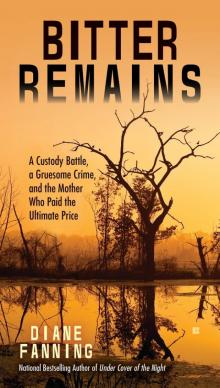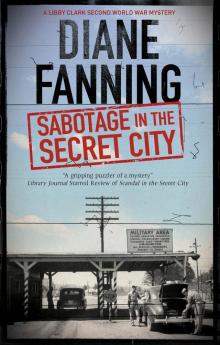- Home
- Diane Fanning
Sleep My Darlings Page 5
Sleep My Darlings Read online
Page 5
Within six months of their arrival on that base, Julie refused to take her medications—a fairly typical reaction by those suffering with bipolar disorder. The drugs needed to minimize the lows of depression at the cost of the highs of the mania often turn the world into a very flat place where nothing can seem to generate any strong emotional response. Many patients have rebelled against this overly placid state of mind.
Julie had continued to balk against taking her medication when the family returned to the United States, where they purchased a home on Railbed Drive in Odenton, Maryland, and got busy making home improvements.
Julie’s nonstop six-month period of mania, caused by her noncompliance with her prescriptions, finally overwhelmed Parker. Along with an unnatural elevation of mood and energy levels, this phase was marked by agitation, irritability, poor temper control, reckless behavior, false beliefs, and poor judgment—a difficult combination of manifestations for any family with a bipolar member to handle on their own. He took Julie to Walter Reed Hospital for treatment of her mental disorders in early 2006.
CHAPTER 10
On August 1, 2006, Parker Schenecker finally received the promotion that had eluded him for so long. He was now Colonel Schenecker. That elevation meant that the Schenecker family was uprooted again. Parker was sent to the U.S. Army War College at Carlisle Barracks, the second-oldest active military base, nestled in the stunning, lush beauty of Pennsylvania’s Susquehanna Valley.
The town of Carlisle traced back to prerevolutionary days when it served as the jumping-off point for pioneers and adventurers traveling over the Allegheny Mountains to points west. The first military encampment dated back to 1756, when the site played a prominent role in the French and Indian War.
The onset of the American Revolutionary War spurred the establishment of a more permanent presence with the construction of substantial brick buildings on the grounds. Intense military activity erupted there again in 1794 with the commencement of the Whiskey Rebellion, an uprising by farmers who refused to pay tax on the whiskey they distilled from their corn crops.
When President George Washington traveled there during that conflict, he reviewed a contingent of ten thousand troops. He was impressed by what he saw at Carlisle Barracks and wanted to make it the site of a federal military academy. That honor went, instead, to the state of New York at its West Point location. In addition, during this period of history Carlisle was one of forty sites competing to be the location of the new federal capital.
During the Civil War, the base became a central supply center for the Union forces, providing weapons, ammunition, horses, and quartermaster supplies to the soldiers. In 1863, Confederate forces shelled the town and torched the barracks.
The control of the facility was passed to the Department of Interior in 1879 when the Bureau of Indian Affairs was charged with opening the Carlisle Indian Industrial School, the first boarding school for the education and enculturation of Native American children. Students from the western Indian tribes flocked to the institution for its curriculum that combined an academic program emphasizing English language skills with vocational training to prepare them for successful transition to becoming productive workers in American society.
World War One brought the facility back under the purview of the War Department, and after this conflict it began its reconfiguration as a predominately educational facility with the opening of the Medical Field Service School. At the end of those hostilities, five additional instructional centers opened: the Army Information School, School for Government of Occupied Areas, Chaplain School, Military Police School, and Army Security Agency School.
Finally, in the spring of 1951, the U.S. Army War College moved from Washington, D.C., to Carlisle Barracks. By the time of Parker’s arrival, the institution had long established its position as the army’s ultimate professional development base, preparing officers for the responsibilities of strategic leadership in a joint, interagency, intergovernment, and international environment.
Parker immersed himself in this inquiry-driven model of graduate study to master the strategic arts in the three different areas: as a leader, a theorist, and a practitioner. He learned about the history of warfare and conflict, in order to understand the underlying causes as well as gain insights for the future, and the universe of existing theory to enhance his ability to develop new strategic concepts for any situation.
Parker and Julie settled their children into a home on Hope Drive in a suburban area about a mile away from the center of the picturesque village of Boiling Springs, wrapped around the serene Children’s Lake. Situated on the Appalachian Trail, it was one of the nine towns in the country designated as an Appalachian Trail Community.
The name of the village arose from the natural artesian-well springs in and around the town, the most prominent one known as “the bubble.” These formations caused the temperature in the lake to remain at a constant fifty-two degrees Fahrenheit all year round, causing it to steam continuously during the colder-weather months. With fewer than three thousand residents, Boiling Springs projected a warm small-town ambience, with 98 percent of the population white and the remaining portion fragmented into small allotments of black, Native American, Asian, Pacific Islander, and other ethnic groups.
The Schenecker’s new neighborhood was a blissful segment of upper-middle-class suburbia built a couple of years earlier on a piece of farmland. It was surrounded on two sides by operating farms. The residents were a blend of young families with small children, middle-aged families with teenagers, and empty nesters and/or retired folks. The houses there were two- to three-thousand square-foot homes in two styles: modern and colonial. The one that Parker and Julie bought was a pretty yellow two-story colonial complete with shutters.
Quiet, small, with little traffic, it was often called Mr. Rogers’ Neighborhood by locals. The residents, for the most part, were nice, friendly people who smiled as easily as Mr. Rogers did. Although there were some shopping and dining opportunities a mile away in the village, folks who lived in the Scheneckers’ community usually traveled to the larger Carlisle to buy groceries, clothing, and other essentials or to go to a restaurant. Many elected to live in the Boiling Springs area because of its good school district, with small, manageable schools, where their children could feel at home.
Beau Schenecker’s personality blossomed in this environment, revealing a likeable and loveable person who quickly made and retained friends worldwide. Although shorter than average for boys his age, he gained stature through his amazing intuition, empathy for others, and a great sense of humor.
One of his friends in his typing class, Emily Corica, sat directly behind him. They goofed around together and during the winter shared the mutual problem of constantly chapped lips. They’d tease each other over their minor affliction, but Emily said she always won those playful battles because Beau’s lips were always in worse shape than hers.
A highlight of the time Calyx spent here was her art classes. She learned to work in charcoal, ink and wash, pastels, watercolors, and acrylics. A piece of her work, an illustration of her military family, was entered into the 2007 Armed Services YMCA art contest. Of the twelve grand prize winners across the country, Calyx was the top winner out of all the army entries. She was awarded a five-hundred-dollar U.S. Savings Bond.
From their arrival in this idyllic setting Julie appeared to be doing quite well. She seemed stable and mentally healthy. Parker graduated from the U.S. Army War School in May 2007. They sold their home for $345,000 and the family moved south. Parker’s next position was as the deputy NSA (National Security Agency) representative to CENTCOM (Central Command) in Tampa, Florida, at MacDill Air Force Base. He was mainly responsible for the National Security Agency’s support to military operations.
In addition to added prestige and responsibility, Parker was now earning in excess of one hundred thousand dollars per year. Despite the Scheneckers’ improved economic situation and their envious deployment to a base
with balmy winter temperatures and close proximity to the beach, it was here that Julie’s mental health faltered and eventually disintegrated.
CHAPTER 11
Tampa, Florida, recently ranked as the fifth-best outdoor city by Forbes and as a top city for twentysomethings by the Washington Square News, has a diverse history. An influx of Cubans and Spanish workers were brought in to build the cigar industry in 1886. Peak production of 500 million hand-rolled cigars was achieved there in 1929, making Tampa the “Cigar Capital of the World.”
That Spanish-speaking population was followed by the arrival of Italian and Eastern European Jewish emigrants who built businesses and shops to serve the cigar workers. When Henry Platt’s railroad development led him to erect the Tampa Bay Hotel, a quarter-of-a-mile-long Moorish Revival–style luxury resort, tourism took root and exploded, expanding the influence of that industry in the area.
The hotel and its manicured gardens on the banks of the Hillsborough River stand today but now house the University of Tampa.
When the Scheneckers first arrived in this subtropical city on the picturesque Gulf Coast, they rented a place on Whisper Pointe Drive while they looked to purchase a more permanent home. On May 1, 2008, they bought a house located in North Tampa in the Ashleigh Reserve gated suburban community, at 16305 Royal Park Court. An eight-year-old two-story single-family residence with a 10,584-square-foot lot was priced at $448,000. The Scheneckers made a down payment of approximately $90,000 and obtained a mortgage for the balance. Unfortunately, property values in the state and most particularly in Tampa were about to plummet.
* * *
Early in 2008, Julie grew entranced by the writings of German New Age author Eckhart Tolle and his book A New Earth: Awakening to Your Life’s Purpose, an Oprah Winfrey Book Club selection. His thoughts on page 22 particularly captured Julie’s attention:
You then no longer derive your identity, your sense of who you are, from the incessant stream of thinking that in the old consciousness you take to be yourself. What a liberation to realize that the “voice in my head” is not who I am. Who am I then? The one who sees that. The awareness that is prior to the thought, the space in which the thought—or the emotion or space perception—happens.
Ego is no more than this: identification with form, which primarily means thought forms. If evil has any reality—and it has a relative, not absolute, reality: this is also its definition: complete identification with form—physical forms, thought forms, emotional forms. This results in a total unawareness of my connectedness with the whole, my intrinsic otherness with every “other” as well as with the Source.
This forgetfulness is original sin, suffering, delusion.
Julie logged on to Oprah.com and wrote about this passage: “I used to think I was lulu/split personality because of how much information I could ‘download’ prior to a thought. This made me sob when I, at 47, was finally validated by the ‘space before the thought.’ I’m just so grateful to Eckhart for letting me know this is the me that should have been shining all these years.”
Julie also relished an earlier work of Tolle’s, The Power of Now. In it, the author insists that death is an illusion, a mere portal to happiness: “The body that you can see and touch is only a thin, illusory veil. Underneath it, lies the invisible inner body, the doorway into Being, into the Life Unmanifested.”
Despite the fact that Tolle sold more than 10 million copies of his book, Time magazine referred to the philosophical underpinnings of his work as “spiritual mumbo-jumbo.” Christian theologians deemed his work dangerous because he made no distinction between human beings and the deity. Psychiatrists and psychologists were equally alarmed at the possible impact that his teachings would have on those with serious mental health issues, people who are often impacted in a disproportionate manner by religious and spiritual exhortations.
If these writings were a tipping point for Julie, feeding into the psychosis inherent in her schizoaffective disorder, it was not immediately apparent. Certainly her depression came and went during her first year in Tampa, leaving her in a state of lethargy that caused her to ignore housekeeping and meal preparation responsibilities. Only Julie knew whether or not this roller-coaster emotional ride was the result of ineffective pharmaceuticals or caused by her noncompliance with the prescribed instructions of her physician.
Even though the topic of possible divorce came up now and again, Parker and Julie were able to mend fences and move forward. She still demonstrated the signs of a good mother who cheered at the kids’ athletic events and learned the latest pop songs to sing along with them when she picked Calyx and Beau up after school.
In 2009, life seemed to hold great promise for the Schenecker family. They’d settled into their new home, the children made friends at school, and Julie gathered a clutch of women friends in the area.
One of Julie’s friends, Lorraine Livingston, became a prominent part of her life that year. The two women bowled, played tennis and lunched together, and made each birthday of anyone in their group of friends a special occasion. The group also exchanged gifts over the holidays. One year, Julie presented each one of her friends with stationery with her initials on it. Another time, she gave them all gold necklaces. Lorraine described Julie as a good friend, a lovely woman with unsurpassed elegance.
Lorraine and Julie were also quite active as volunteers, working together for many charitable causes, including the Muscular Dystrophy Association. They volunteered to help out with the Tampa Bay Pro-Am at the Tournament Players Club Tampa Bay in Lutz, Florida, with its Bobby Weed—designed course, in April. The event paired Champion Tour professionals with special guests, celebrities, and local amateur stars to raise money for nonprofit organizations. Over the twenty-four years of the Tampa Bay Pro-Am Foundation’s existence, they’d contributed a total of $9 million to many different groups.
The 2009 event raised money for four charities: Diabetic Charitable Services, which aided in early detection of the disease and provided help in monitoring and controlling it; the Child Abuse Council, with its child abuse prevention and family education programs; Everyday Blessings, a child placing and caring agency; and the Judeo Christian Health Clinic, which provided free, compassionate care to indigent Tampa Bay residents. That year was a star-studded tournament. In addition to prominent professional names in the world of golf, such as Hale Irwin, Tom Watson, and Nick Price, a lot of celebrities participated in the event. Comedian Bill Murray played and hit an accidental hook shot that beaned a woman in the head at the ninth hole. Actor Michael J. Fox, a longtime survivor of Parkinson’s disease, stirred hearts with his emotional finish on the eighteenth hole. Also golfing in the event were NFL Hall of Famers Emmitt Smith and Jerry Rice and other former NFL players such as Ronde Barber and Vinny Testaverde; comedian George Lopez; singer Vince Gill; actors Kevin Costner and Mark “Marky Mark” Wahlberg; and NBC’s Stone Phillips.
Julie and Lorraine got close up to them all when they worked the Outback Steakhouse Pro-Am Aussie Bash, a private party for sponsors, players, and VIPs on April 13. The party featured heavy hors d’oeuvres, an open bar, and live entertainment by country singer Tim McGraw.
In January 22, 2009, Parker, Julie, and Calyx traveled with Parker’s mother, Nancy, to celebrate at a debutante ball. No one noticed any discord between mother and daughter—Julie and Calyx seem to get along wonderfully.
In September of that year, Parker returned to his old high school in Texas, Fort Worth Country Day School, to receive the Service for Humanity Award. They cited his exemplary military service and enumerated the many honors he’d received in his illustrious career: Defense Meritorious Service Medal, Army Meritorious Service Medal, Army Commendation Medal, Air Force Achievement Medal, Southwest Asia Service Medal with a Bronze Service Star, Iraq Campaign Medal, Afghanistan Campaign Medal, Global War on Terrorism Expeditionary Medal, Global War on Terrorism Service Medal, Joint Meritorious Unit Award, Army Superior Unit Medal, National Defense Service Medal, Over
seas Ribbon, Army Service Ribbon, the Knowlton Award for Excellence in Army Intelligences, and the German Army Service Cross in Silver.
In October 2009, when Julie returned to Iowa for a reunion with her college basketball team, something about her didn’t seem quite right to her old friends. She was far more subdued. “She was not the same bubbly person I had known and I thought her eyes looked a little bit either distant or vacant,” teammate Lisa Pilch said, adding that when she’d seen Julie five years earlier at another reunion she’d been her old self.
Still Julie gave no indication that anything was amiss during their time at the restaurant or the UNI football game. She updated everyone about her children’s lives and took an active part in conversations, but on reflection, teammate Lisa Pilch thought that Julie never discussed anything in depth.
Nonetheless, when Beau called while the women were at lunch Julie spoke to him like any other mother would talk to her son. She didn’t indicate that there were any problems. She gave every appearance of loving her life.
Thanksgiving that year was a family-oriented delight. Parker’s mother, Nancy Schenecker, and Julie’s parents, Jim and Patty, traveled to Tampa to gather around the family table. Julie’s friends dropped by the house that weekend to meet the parents. No conflicts erupted and all seemed well in their world.
Looking back, it was easy to see that this peaceful time was nothing more than the proverbial quiet before the storm. The winds of disaster were gaining strength, pushing the axis of the Schenecker family’s world into a critical tilt. It would not be long before everything spun out of control.
CHAPTER 12
After Christmas 2009, Parker posted several photos of his family of four on his Facebook page. One shot was a dramatic black-and-white that caused one of his friends to write: “Did you find the fountain of youth and you’re not telling anyone?!!!!”

 Death on the River
Death on the River Bitter Remains
Bitter Remains Gone Forever
Gone Forever Sleep My Darlings
Sleep My Darlings A Poisoned Passion
A Poisoned Passion Through the Window: The Terrifying True Story of Cross-Country Killer Tommy Lynn Sells (St. Martin's True Crime Library)
Through the Window: The Terrifying True Story of Cross-Country Killer Tommy Lynn Sells (St. Martin's True Crime Library) Chain Reaction
Chain Reaction Baby Be Mine
Baby Be Mine The Pastor's Wife
The Pastor's Wife False Front (Lucinda Pierce)
False Front (Lucinda Pierce) Under Cover of the Night
Under Cover of the Night Sabotage in the Secret City
Sabotage in the Secret City Written in Blood
Written in Blood Treason in the Secret City
Treason in the Secret City Wrong Turn
Wrong Turn Under the Knife
Under the Knife Mommy's Little Girl
Mommy's Little Girl Scandal in the Secret City
Scandal in the Secret City